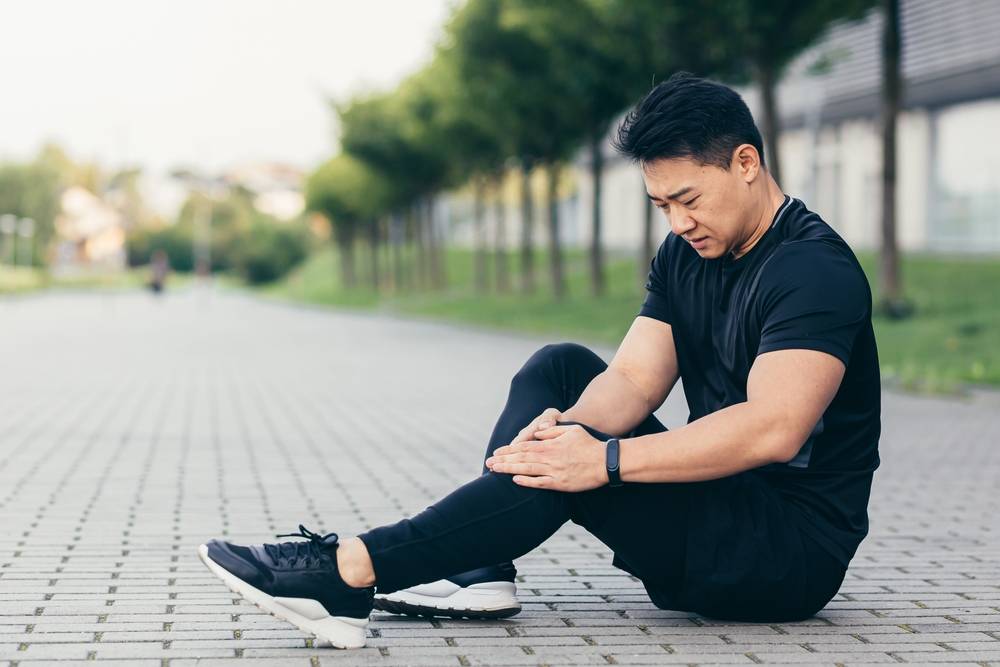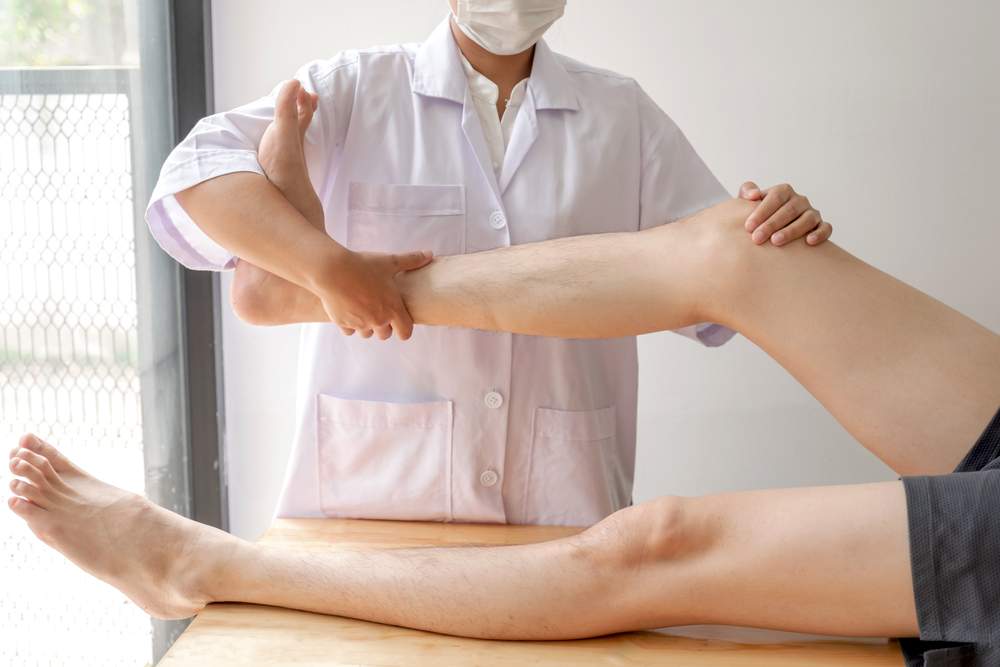 You might not realize just how much you depend on your joints for everyday routines and activities until you start experiencing joint pain. An injury or health condition can make simple tasks uncomfortable and painful, like reaching above your head to pick up something off a shelf or walking up and down a flight of stairs. Bones come together at joints and allow you to bend, twist, and move around. Sometimes you might get some minor and temporary joint pain from putting too much pressure or strain on your joints, which might go away after a few days. But how do you know when to see a doctor for joint pain?
You might not realize just how much you depend on your joints for everyday routines and activities until you start experiencing joint pain. An injury or health condition can make simple tasks uncomfortable and painful, like reaching above your head to pick up something off a shelf or walking up and down a flight of stairs. Bones come together at joints and allow you to bend, twist, and move around. Sometimes you might get some minor and temporary joint pain from putting too much pressure or strain on your joints, which might go away after a few days. But how do you know when to see a doctor for joint pain?
If you suffered a recent injury or notice joint pain that won’t go away, you want to talk to your doctor. Your primary care physician may recommend you see an orthopedic doctor, which is a doctor who specializes in injuries and conditions that affect the whole musculoskeletal system, including your joints. If you try to push through the pain, you can accidentally end up making an injury or joint condition worse. The sooner you reach out to a doctor about pain, the sooner you can get started on treatment options to help bring you lasting pain relief.
Common Causes of Joint Pain
The human body has over 300 joints that help support your skeleton and everyday movements. You could develop joint pain in your shoulders from playing sports or in your joint pain in your knees from lifting something too heavy. Here are some common causes of joint pain.
Arthritis
Arthritis is one of the most common causes of joint pain. Osteoarthritis is the type of arthritis people are most familiar with, often referred to as wear and tear arthritis. Many people develop osteoarthritis as they age because of how regular wear and tear on the body has impacted their joints over time. Arthritis causes joints to become inflamed, and the bones that come together inside the joint may rub against one another. If you have arthritis, the cartilage that helps cushion the joints and prevent bones from touching will start to wear away with time. Deterioration of this joint lining will lead to an inflammatory response followed by pain, stiffness, and swelling. Arthritis can occur in any joint, though it commonly affects joints like the hands, wrists, knees, and hips.
Bursitis
Your joints also have fluid-filled sacs known as bursae that provide lubrication and support. Bursae help reduce friction when muscles, tendons, and bones move around in the joints. If one of these bursae becomes inflamed, it is known as bursitis. Inflamed bursae can lead to pain and discomfort in the joint area that may get worse with certain motions or activities. Bursitis can also start to restrict your range of motion. People who develop bursitis may also notice swelling and redness of the skin around the joint. The location of bursitis will also depend on your symptoms. For example, bursitis in your knee can make it difficult to bend your leg, while bursitis in your hip can make it difficult to find a comfortable position to sleep in.
Acute Injury
A sudden injury, also known as an acute injury, can lead to joint pain and discomfort. One example of an acute injury is a sprained ankle, which can happen if you roll, twist, or awkwardly turn your ankle. You might trip and fall, landing awkwardly on your foot, or you could land poorly on your feet after a jump. An ankle injury or other sudden injury to a joint can cause nearby tissues like muscles and tendons to overstretch or tear. Your joints rely on these strong bands of tissue to help the joint function properly and provide effective support and stability. When these tissues become overstretched or torn, it can make it difficult to move your affected joint properly. You can experience a limited range of motion, along with pain, bruising, swelling, and inflammation in the area.
Overuse Injury
Overuse injuries can develop over time with repetitive movements or overloading your joints with strenuous activity. Overuse injuries are common in athletes of all skill levels and can occur due to improper form or too much repetitive activity without enough rest or breaks in between. When you don’t give your body enough time to recover after exercise, you can become more susceptible to an injury. Common overuse injuries that affect the joints include carpal tunnel syndrome, tennis elbow, golf elbow, and jumper’s knee. Repetitive pressure and strain on the tissues that support your joints can also put you at greater risk for weakened or torn muscles, ligaments, and tendons.
Tendonitis
Tendonitis refers to inflammation, tenderness, and pain that develop around a joint. Unlike arthritis, tendonitis refers to inflammation in the tendons and other tissues around the joint area. The tendons that help connect muscles to bones of a joint can become inflamed and make everyday movements uncomfortable. Tendonitis can develop in any tendons in the body, though it is common in tendons that support joints like the shoulders, elbows, wrists, and knees. Sports and activities that depend on repeated motions and activities, like running or tennis, can put you at greater risk for developing tendonitis.
Infection
You could also develop an infection in one or more joints that can cause significant pain and discomfort. If bacteria get into a joint, it can cause cartilage and joint lining to deteriorate, damaging the bones of the joint. Damage to cartilage and bones in a joint can cause pain, swelling, and redness in the area. An infection can also lead to restricted movement. Bacteria from a staph infection or strep throat could travel to your joints and cause a joint infection. Health conditions like rheumatoid arthritis, lupus, or gout can also put you at greater risk for infection.
How to Manage Joint Pain at Home
In some cases, you might be able to manage your joint pain at home. If you have already been diagnosed with osteoarthritis or rheumatoid arthritis, then you might already know about some home remedies to help reduce your pain and discomfort. While no treatment is available to eliminate arthritis or prevent it from returning, there are things you can do at home to help manage your discomfort. Topical pain relievers or oral medications can help reduce inflammation and provide temporary pain relief. You can also apply ice and heat to affected joints, which can help with pain and stiffness in the joints. A cold compress or ice pack can help reduce swelling and inflammation in the joint while also providing a temporary numbing sensation. A warm compress or heating pad can help soothe stiff, aching muscles that support your joints and help make movements easier. Building in plenty of time to rest in between activities will also help give your joints a chance to recover. Always stretch before working out or playing a sport and alternate with low-impact exercises that are easier on the joints, like swimming or yoga.
When to See a Doctor for Joint Pain
 You should see your doctor if you develop joint pain and other unexplained symptoms and cannot determine the cause. If you notice a swollen joint becomes tender and warm to the touch, you should see a doctor. Pain that lasts for three days or more should get checked out by your doctor. Joint pain accompanied by a fever could also indicate an infection, which would require medical attention. A sudden injury where you notice sudden swelling or your joint appears deformed will typically require emergency medical attention. You may also need to visit the emergency room or urgent care if your joint pain is so severe that movement becomes difficult or if your joint is completely immobile after an accident.
You should see your doctor if you develop joint pain and other unexplained symptoms and cannot determine the cause. If you notice a swollen joint becomes tender and warm to the touch, you should see a doctor. Pain that lasts for three days or more should get checked out by your doctor. Joint pain accompanied by a fever could also indicate an infection, which would require medical attention. A sudden injury where you notice sudden swelling or your joint appears deformed will typically require emergency medical attention. You may also need to visit the emergency room or urgent care if your joint pain is so severe that movement becomes difficult or if your joint is completely immobile after an accident.
Early Diagnosis & Treatment Can Help You Recover Faster
Most of the time, it’s better to be safe than sorry when it comes to joint pain. You would probably rather a trip to the doctor for something that turned out to be minor instead of waiting too long and ending up with severe pain or joint damage. The sooner you get an accurate diagnosis for what is causing your joint pain, the sooner you will be able to get started on treatment to help relieve your discomfort. An orthopedic doctor will determine and address the root cause of your joint pain so you can experience lasting relief. In some cases, your doctor may want to run tests or use diagnostic imaging like an X-ray or CT scan to determine the cause or rule out other injuries. In cases of serious injury to a joint, your doctor may recommend surgery.
Don’t let joint pain affect your quality of life! Visit your Jonesboro orthopedic doctor at AICA Orthopedics and learn more about all your treatment options available. Our orthopedic doctors work alongside chiropractors, neurologists, and physical therapists to provide you with comprehensive care and solutions to manage and relieve your joint pain.
